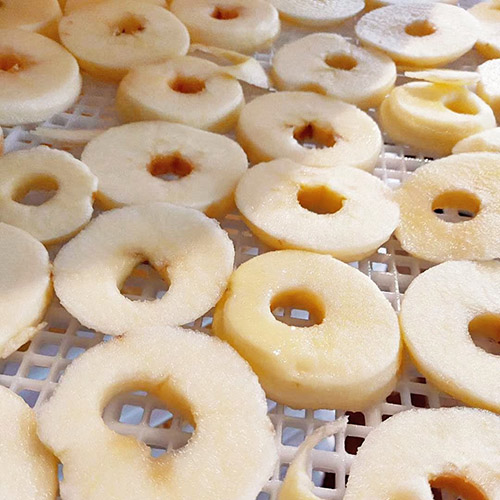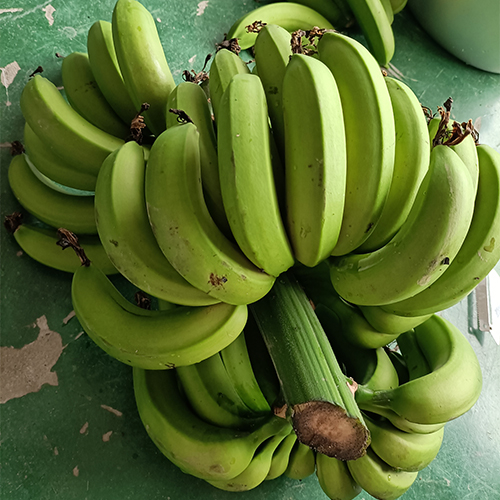
Apple Dehydration
Dehydrating Fruit: Quarter and thinly slice apples. Dry at 135 degrees Fahrenheit for 8 to 12 hours.
Cut the apples in quarters from top to bottom, then remove the core and stem. Cut the quarters crosswise into 18- to 14-inch thick sections.
Dehydrate apples for 8-12 hours at 135°F (57°C) until pliable.
Apples will begin to turn somewhat brown within minutes after being chopped and exposed to air, a process known as oxidation. If you dehydrate your apples straight away, the colour change will be minimal, and the vitamin content and taste will be well preserved. After being exposed to oxygen, the flesh of pears, peaches, and apricots also oxidises.
Pretreat apples with the lemon juice or ascorbic acid solutions suggested earlier to reduce oxidation.
Apples with Pumpkin Spice
Apple dehydrating projects include drying grated apples, baked apples, stove-cooked apples, and applesauce. Tortilla Apple Tarts, Apple-Berry Muesli, and Pumpkin Spice Apples recipes.
Apricot Dehydrator
Apricots are a fruit that dehydrates well.
Wash apricots, cut in half, remove pits, then cut each half into four lengthwise slices. Then, four times across, slice each of those pieces.
Spread apricot chunks on mesh dehydrator sheets in a single layer.
Dehydrate apricots for 11 hours at 135°F (57°C) until flat, malleable, and almost snappy.
Trail mix of dried fruits, including dried apricots on the right.
Above: dried apricots on the right, and fruit cocktail mix on the left.
For the apricot salsa recipe, cut apricots with mint.
Ingredients for apricot-mint-salsa, photographed.
Apricot Dehydrating Projects: Apricot Preparation, Apricot Fruit Leather Recipes, Apricot Fruit Leather Pudding Cold-Soak Apricot Salsa Rice Salad, Apricot-Mint Salsa.

Banana Dehydration
Banana slices on an Excalibur dehydrator pan.
For optimal sweetness, choose bananas with brown speckles on the peel, but avoid drying overripe, squishy bananas.
Peel the bananas and cut them into 18-inch to 14-inch thick slices crosswise. Dip the banana slices in lemon juice before drying if desired.
Dehydrate bananas at 135°F (57°C) for 8-12 hours, or until chip-like or leathery.
Removing dried bananas off the Excalibur dehydrator tray's mesh sheet.
It can be tough to remove dried bananas from hard plastic dehydrator trays. Using flexible poly-screen tray inserts, such as those included with Excalibur dehydrators, makes removing the dried bananas much easier.
Fruit leather recipe using bananas and pineapple.
Ingredients for banana-pineapple fruit leather (photo).
Dehydrating Bananas Projects: Banana Fruit Leather, Banana-Pineapple Pudding, Banana Split Pudding, Banana Pudding with Chocolate & Nuts, Banana Nut Bread Pudding, and Grahma Nanna Nilla Pudding.
Dehydrating Berries
Blueberries are only fair for snacking on plain. They are delicious in oatmeal, muesli, trail mixes, and as a topping for dry angel food cake when rehydrated and reheated. They can also be mixed with other fruits creating fruit leather.
Blue berries sliced into half and quarters for dehydration.
Wash blueberries and remove the stems.
Blueberries will dry faster and turn out crispier if you cut the berries in half, or even quarters, as illustrated above. An option to cutting the blueberries is to break the skins using the same method: Place blueberries in a colander and dip in boiling water for 30 seconds and then in cold water to check (break) the skins. Blueberries will take significantly longer to dry using the checking approach.
Place the blueberries in a single layer on the dehydrator tray.
Dehydrate blueberries at 135°F (57°C) for 14-16 hours, or until leathery.
Apples, bananas, raspberries, blueberries, and strawberries dehydrated.
Apples, bananas, raspberries, blueberries, and strawberries dehydrated. Perfect in Bircher Muesli.
Blueberries can be used to make fruit leathers as well as dried and processed into fruit powder.
Fruit powders that have been dehydrated.
Fruit Leather and Fruit Powder are being dehydrated.
Raspberries and Blackberries Dehydrated
Blueberries, raspberries and blackberries, for example, are only suitable for nibbling on their own, but they add colour and nutrients to trail mixes, fruit cocktails and muesli. They are also delicious when combined with fruit leather. One disadvantage to dehydrating raspberries and blackberries is that they produce a lot of seeds. Each berry is composed of approximately 100 drupelets, each of which contains a seed.
Raspberries can be dried by cutting them in half. Dehydration will proceed considerably more quickly than if the berries are dried intact. Small blackberries can be cut in half, but giant blackberries should be cut into 14-inch slices, as illustrated below.
Blackberries and raspberries are sliced and dried.
Raspberries and blackberries can be dehydrated directly on mesh sheets at 135°F (57°C). Small raspberries, split in half, will dry in 10 to 12 hours. Larger blackberries may require 14-16 hours to cook.
Blackberries and raspberries that have been dehydrated.
Dehydrated blackberries and raspberries are shown in the photo.
Strawberries that have been dehydrated
Dried strawberries are only suitable for nibbling on their own, but they are wonderful in trail mixes, fruit cocktails, fruit leathers, and Trail Angel Cake when rehydrated and heated with chocolate sauce.
Strawberries on an Excalibur dehydrator tray.
Wash and wipe dry strawberries with paper towels, or wash and spin them in a salad spinner. Remove the leafy cap of the strawberries and cut them into 14-inch thick slices crosswise.
Sprinkle with sugar after placing the pieces on the pans if you wish to sweeten them. Sweetening the strawberries in a bowl first pulls out the juices, making them more difficult to work with.
Strawberries that have been dehydrated.
Strawberries should be dehydrated at 135°F (57°C) for 6-8 hours. When testing for dryness, dried strawberry slices will be very thin and will split in half.
Fruit leather is made with oranges and strawberries.
Ingredients for strawberry-orange fruit leather (photo).
Strawberry Powder, Strawberry Tortillas with Chocolate or Peanut Butter, and Strawberry Trail Angel Cake are all strawberry dehydrating projects.
Strawberry Fruit Leather: How to create it, many recipes, how to pack it, and how to use it to make delightful puddings and snacks.
Cantaloupe is being dehydrated.
Cantaloupe dehydration before and after.
Remove the seeds from the cantaloupe and cut each half into 14-inch thick slices.
Remove the rind and chop the flesh into strips or chunks.
Dehydrate cantaloupe at 135°F (57°C) for 8-10 hours, or until no moisture remains when a piece is torn in half. Cantaloupe that has been dried will be malleable.
How to Dehydrate Cantaloupe and Make Cantaloupe Fruit Leather
Cherry Dehydration
Dried cherries are chewy and delicious. They are high in Vitamin C and are ideal for snacking. They are also delicious in trail mixes, fruit cocktails, and any trail dish that has chocolate.
Dehydrating cherries by cutting them into quarters.
The photo above depicts the suggested method for cutting cherries for drying. When dried in quarters, they dry more uniformly and quickly than when dried in halves. Bottom right: dried quartered cherries.
Run a sharp knife around the cherry from top to bottom. Then, rotate the cherry 90 degrees and cut it again from top to bottom. Remove the pit by separating the quarters.
Spread quartered cherries in a single layer on a dehydrator mesh sheet.
Dehydrate the cherries for 14-16 hours at 135°F (57°C).
Our company
JIMU is established since 2002 year, specializing in technology developing, manufacturing and marketing of heat pump dryers. With more than 20 years professional experience, our CEO and technical team provide excellent drying solution design and customized services. So far, we get CE, FDA and many other certifications. Compared with traditional drying equipment, JIMU heat pump dryer will dry the material gently to keep color, smell and shape perfect. Meanwhile saving around 75% energy consumption.
MAKE THE DRYING EASY
It’s JIMU’s target. Easy model selection, easy transportation, easy installation, easy operation, moreover, easy in the cost. Choose JIMU heat pump dryer, choose an easier drying way. JIMU’s unique negative pressure air distribution design to ensure the even drying effect for almost all drying materials. JIMU’s closed drying system will steady work in any ambient condition. One piece design drying room will be perfectly suitable for container loading, you don’t need installation, but just connect to power supply to start drying by JIMU machine. Compact structure reduces the cost of machine observably, let the whole drying solution economic.
Let us know information of the material, also your question or confusion of drying process, JIMU will provide a tailor made solution for you immediately. JIMU Dryera heat pump dryer, MAKE YOUR DRYING EASY.












